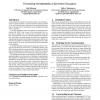Free Online Productivity Tools
i2Speak
i2Symbol
i2OCR
iTex2Img
iWeb2Print
iWeb2Shot
i2Type
iPdf2Split
iPdf2Merge
i2Bopomofo
i2Arabic
i2Style
i2Image
i2PDF
iLatex2Rtf
Sci2ools
110
click to vote
CCS
2010
ACM
2010
ACM
On the soundness of authenticate-then-encrypt: formalizing the malleability of symmetric encryption
A communication channel from an honest sender A to an honest receiver B can be described as a system with three interfaces labeled A, B, and E (the adversary), respectively, where the security properties of the channel are characterized by the capabilities provided at the E-interface. A security mechanism, such as encryption or a message authentication code (MAC), can be seen as the transformation of a certain type of channel into a stronger type of channel, where the term "transformation" refers to a natural simulation-based definition. For example, the main purpose of a MAC can be regarded as transforming an insecure into an authenticated channel, and encryption then corresponds to transforming an authenticated into a fully secure channel; this is the well-known Encrypt-then-Authenticate (EtA) paradigm. In the dual paradigm, Authenticate-then-Encrypt (AtE), encryption first transforms an insecure into a confidential channel, and a MAC transforms this into a secure channel....
CCS 2010 | Encryption | Secure Channel | Security | Security Privacy |
Related Content
| Added | 06 Dec 2010 |
| Updated | 06 Dec 2010 |
| Type | Conference |
| Year | 2010 |
| Where | CCS |
| Authors | Ueli Maurer, Björn Tackmann |
Comments (0)

